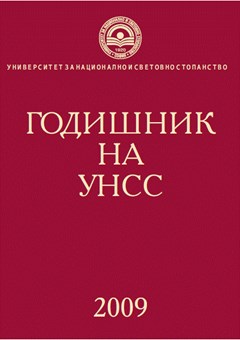Към въпроса за международните пари
Author: Милчо Стоименов
On the Issue of International Money
Milcho Stoimenov
Abstract
Парите органически са свързани със стоковото производство и размяната. В своята многовековна история те приемат различни форми – стокови пари, металически пари, банкноти, кредитни пари, книжни пари, електронни пари. Общото за тях е, че те са единствено приемано от всичките субекти разменно средство, че улесняват стоковата размяна и са по-добрата алтернатива на бартера.
Съвременните пари могат да бъдат характеризирани като декретни (в смисъл, че се опират единствено на узаконяването им от държавата в лицето на нейния законодателен орган), кредитни (относно онази част от емисията, която е свързана непосредствено с депозитнокредитните операции на търговските банки и монополната емисионна функция на централната банка) и книжни (по отношение на пусканите в обръщение пари за финансиране на бюджетен дефицит).
Международните пари обслужват международния икономически обмен. Те възникват като резултат от интернационализацията на национални валути или като наднационални пари. В първия случай международните пари са представени от валути, които изпълняват парични функции зад пределите и извън юрисдикцията на съответната страна емитент. Във втория случай това са регионални или глобални парични единици, създадени на основата на колективни споразумения между страните.
Електронните пари и глобализацията тласкат света към единна световна валута, към ликвидиране на вековния монетарен плурализъм. Такава идея обаче е трудно осъществима. Човечеството все още е далече от такава революционна трансформация, но е устремено към нея. Достигането до такава глобална структурна промяна вероятно ще премине през създаването на колективни (регионални) пари от типа на еврото в мащабите на валутни зони.
Най-вероятно е към средата на настоящия век в света да се оформят три валутни зони – на еврото, на щатския долар и на някаква обща валута на страните от Азия, изградена с преобладаващо участие на йената (Япония) и на юана (Китай). Може определено да се каже, че съвременната цивилизация се движи към три регионални централни банки. Чрез тях и на основата на конкуренцията ще се стигне до единна световна валута. Именно конкуренцията ще утвърди – коя от трите валути ще се окаже на “трона” на световната валута. Ако това се случи, светът, развивайки се напред, преоткривайки за трети път парите, ще се върне към един-единствен паричен инструмент, символизиращ самото световно единство.
Abstract
Money has an organic link to the commodity production and exchange. Throughout its history going back many years of time, money takes on different forms, namely, payment in kind, metal money, banknotes, credit money, paper money, electronic money. What these forms all have in common is that they are the only tender for all entities, that they facilitate the commodity exchange and are a better alternative than the barter system.
The present-day money can be described as decree-based, in the sense that it is based only on its legalization by the state , represented by. its legislative body; credit-based – for the part of the issue which is directly linked to the deposit credit transactions of the merchant banks and the monopoly on the issue as a function of the central banks -; and paper-based .(in terms of the money supply issued to finance the budget deficit).
The international money serves as international economic exchange and results from the internationalization of the national currency, or as supranational money. In the first case, the international money is represented by the currencies which fulfill the function of money beyond the borders and outside the jurisdiction of the corresponding issuer country. In the second case, we are looking at regional or global money units created on the basis of the collective agreements between countries..
The electronic money and the process of globalization spur the world on to the common world currency and the elimination of an age-long monetary pluralism. However, this idea is difficult to accomplish. Mankind is yet to achieve this revolutionary transformation, yet it is definitely on the way in this direction. Achieving such a global structural change will probably occur via the establishment of collective (regional) money of the same type as euro, within the scope of different currency zones.
The likelihood is that three currency zones will have been established by the middle of this century – that of the euro, the US dollar and a common currency of Asian countries formed with the prevailing participation of the yen (Japan) and the yuan (China). It may be concluded, with a great degree of certainty, that the contemporary civilization is moving in the direction of three regional central banks and via these banks and through competition a single European currency will emerge. It is none other but competition that will decide which of the three currencies is to be on the “throne” of the world currency. If this comes to pass, in its forward movement the world will rediscover money for the third time and return to the one and only monetary tool symbolizing the world unity itself.

